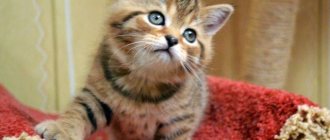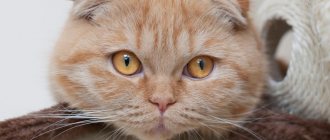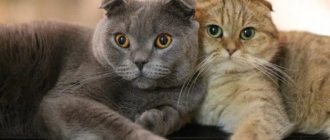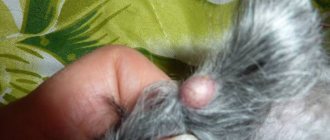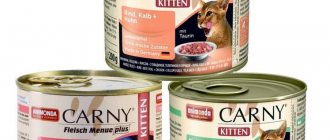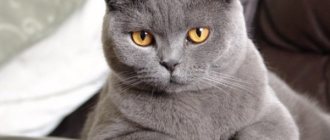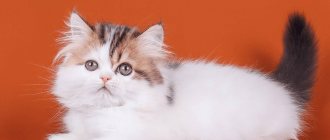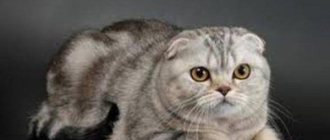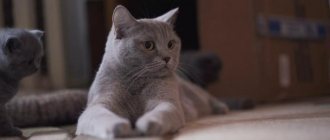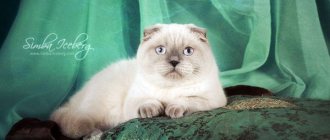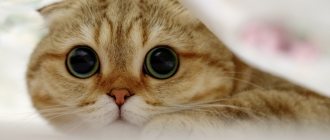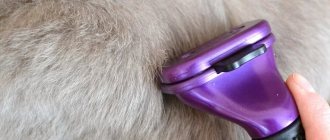- Pets
- >>
- Cat breeds
* Here is a photo of a typical representative of the Scottish Straight cat breed . You can send us photos of your animals by email, and we will post them on the website. Don't forget to send your pet's name.
Other breed names:
Scottish Straight
Video
* We invite you to watch a video about the Scottish Straight cat . In fact, in front of you is a playlist in which you can select and watch any of 20 videos about a given cat breed by simply clicking on the button in the upper right corner of the window. In addition, the material contains quite a lot of photos. By looking at them you can find out what a Scottish Straight cat looks like.
In this article:
|
Rate the material!
[Total votes: 8 Average: 4.6]
The Scottish Straight cat has gained enormous popularity in just half a century. These affectionate, inquisitive and good-natured cats easily get along in a variety of families. They do not require serious care and special educational methods: Scottish Straight cats are smart and easy to train.
History of the origin of Scottish Straight cats
Scottish Straight cats are also called "Scottish Straight". Their history began with the development of the breed of their closest relatives - Scottish Fold cats - Scottish Folds. Scottish Folds appeared back in 1961, but their development was greatly slowed down by the fact that when crossing with representatives of the species, cats gave birth to very sick kittens with impaired musculoskeletal system.
Breeders of the breed were looking for opportunities to develop Scottish Folds, so it was experimentally discovered that Scottish cats with straight ears, when crossed with Folds, produce healthy offspring. By crossing Scottish Folds with ordinary Scottish cats, a breed of straight-eared Scottish cats was developed.
Scottish Straight are cats that, at first glance, are unremarkable. They have long, straight ears, but at the same time there is a gene for drooping ears, which does not go away after crossing. This makes the Scottish Straight ears very soft and thin. Ear cartilage is much thinner than the cartilage of ordinary straight-eared cats. But Scottish Straight kittens are born with floppy ears, so it was only possible to understand which Scottish branch was born when the kitten grew up.
Interesting fact: In 2004, the Scottish Straight cat breed was recognized in Russia and Scottish Straight cats were able to take part in championships and exhibitions. Due to its appearance and characteristic features, Scottish Straights have gained enormous popularity in the CIS countries, becoming even more widespread than in Europe. At the moment, Scottish Straight is one of the most common cat breeds.
Scottish fold color
The genes of the British Shorthair breed gave the Scots the most incredible colors and bizarre shapes
Solid colors are quite rare (if you do not take into account solid colors). Most often, you end up with two or three stacked on top of each other.
We propose to consider the most popular colors of modern tartans.
Tortie suggests the presence of two colors at once: black and red in a variety of ratios.
Smoky is characteristic of wool, where each hair is colored unevenly: the tips are black or dark, and the undercoat is painted in lighter shades. A striking example is the coloring of the chinchilla.
Tabby is perhaps the most popular coloring, second only to solid. Characterized by dark stripes and markings all over the cat's body. A distinctive feature is also a clearly visible mark above the eyebrows in the shape of the letter “M”.
Color-point is a beautiful and very unusual coloring, typical for Neva Masquerade and Siamese cats. In this case, the entire body is painted in a light (white or milky, beige) color, and the tips of the paws, ears and the mask on the face are dark.
Calico is an extremely rare coloration, popularly called the “patchwork turtle.” It is unique to cats and combines bicolor and tortoiseshell. The lower part of the body is painted white, and the upper part is painted in two colors in equal proportions. Such a cat is the dream of any breeder, since her genes can produce kittens with an incredible and varied coat color.
Scottish straight cat - description of the breed
Scottish Straight cats have a number of features that make them easy to distinguish from other cat breeds. For example, their body is quite large and massive, has a rounded shape, although the cat itself looks small and compact. At the same time, the shoulders, pelvis and paws of the Scottish Straight are very well developed, often even muscular.
The paws of the Scottish Straight are round and have a plush appearance. They are also well developed: the cat stands firmly on its feet. The paws are of medium length, and, despite their massiveness, they look graceful and slender.
The head of the Scottish Straight has a rounded, clearly distinguishable shape. The cat even has a slightly “cartoonish” appearance due to this head shape. The Scottish Straight's neck is short but strong. The paw pads are slightly more rounded than other cat breeds. Scottish Straight males are more “cheeky” than females.
The tail of the Scottish Straight can vary in length, but most often it is shorter than that of other cat breeds. Tails are strictly proportional, and a massive cat will never have a thin tail - and vice versa. The tail tapers slightly towards the end and has a characteristic rounding at the tip.
The nose of the Scottish Straight is neat and short, but not flattened, although wide. The nose has a slightly oval shape and a clearly visible base, which makes the cat's profile pronounced and graceful. This nose makes Scottish Straights look even cuter.
Cats' ears are strictly straight, with soft, elastic and slightly stretchy cartilage. Such ears emphasize the round shape of the head and make the cat’s features more expressive and bright. Scottish Straights also have beautiful, wide-open eyes, which sometimes take on a completely round shape and resemble the eyes of an owl. The color of the eyes depends on the color of the cat's fur.
Description of appearance
According to the breed description, this is an elegant medium-sized cat. Due to some roundness of the body and the developed front part of the body, the cat looks quite massive, but most of the effect is achieved due to the dense coat. Scottish Straight is a breed of very dexterous, beautiful and harmonious cats:
- body. Medium-sized body with a well-developed chest and shoulders. All proportions of the cat are respected, although the body is somewhat elongated in length. The muscular frame is well developed. Paws of medium length with rounded pads;
- head. The cat's well-proportioned, rounded head is set on a short, muscular neck. The cheeks, bases of the whiskers and jawline are clearly visible. The nose is wide, proportional, in profile the transition from the forehead to the nose is clearly visible. The ears are small, erect, triangular in shape, wide at the base, harmoniously emphasizing the round shape of the head;
- eyes. Wide-set, round, large eyes give the cat an expression of surprised interest in what is happening. Eye color is directly dependent on the color of the cat;
- wool. The cat's dense coat does not adhere to the body and has a dense, plush structure; it is this structure of the coat that gives cats additional volume and roundness. The coat can be either semi-long or short;
- colors. The Scottish Straight is almost the champion in the number of popular colors; this is an accompanying characteristic of the breed. The colors of cats are as varied as that of their close relative, the Scottish Fold. The most common colors of cats include: chinchilla, lilac, blue, marbled, chocolate, cream, red and black. Such rare colors of cats as black smoke, calico (tortoiseshell) and color point look very impressive.
Fifty shades of round is an apt description for the appearance of an adult cat. It would seem an incompatible variation, but it is so. The general picture when looking at a cat is as if they tried to depict it with a compass, but something didn’t work out, and instead of clear circles we have smooth curves.
Popular colors of Scottish straight cats
Scottish Straights come in a wide variety of colors, each of which is recognized by international associations and organizations specializing in the breeding of these cats. For example, white is one of the common colors for Scottish Straights. It is generally accepted that straight-eared cats have a calm, balanced character and love to be held.
There are also bright red Scottish straights. Dark or light stripes are allowed on the coat, the main thing is that the color is rich and bright. The undercoat of such a cat can be cream or beige, but white spots on the belly, paws and chest are not allowed.
The gray, silver or blue color of the Scottish Straight makes it look like a British cat. Thick blue fur looks impressive. Individuals with amber eyes and a blue tint to their fur are especially prized. All-black Scottish Straights with bright yellow eyes look similarly impressive. In this case, no spots in the color are allowed.
Also, Scottish Straights are characterized by a chocolate color. The coat must have a rich chocolate shade. White spots on the chest and paws are allowed. Interesting is the lilac color - unique among representatives of this breed. Lilac Scottish Straights have a pale beige undercoat and faint, faded red stripes.
The chinchilla color is less common. This is a noble silver color interspersed with dark gray, silver hairs on the top layer of the coat. Scottish Straights rarely have this color, so it is especially valued by cat fanciers' organizations.
In addition, there are the least common colors, such as: bicolor, merle gold, tortoiseshell.
Scottish Straight cat breed: description, standard
It is impossible to describe in words how touching the representatives of this beautiful breed look: plush fur coat, chubby cheeks, round expressive eyes and a touching, naively childish look. And Highland Straight cats also have long fur, so they look not just cute, but chic and majestic.
Straights are not large in size: a cat weighs on average 5-6 kilograms, a female cat weighs from 3.5 to 5 kg. With visual density and heaviness, the animals are very mobile and active, easily standing on their hind legs, for example, to ask for another treat.
Scottish straight. Description of the breed standard:
- The body is proportional, dense, strong, massive.
- Limbs of medium length, short, strong.
- The coat is short, close to the body, plush, soft, with a dense undercoat.
- The tail is medium length, flexible.
- The paws are round and neat.
- The neck is short.
- The head is rounded.
- The forehead is convex.
- The cheeks are dense, round, convex.
- The nose is wide.
- The chin is strong.
- The eyes are large, widely spaced, round. The color matches the coat.
- The ears are straight, erect, set high, with the tips of the ears spread apart.
The most common colors include:
- ginger;
- chocolate;
- white;
- black;
- grey;
- blue;
- lilac;
- cream (beige);
- tortoiseshell;
- bi-color;
- chinchilla;
- ticked;
- color point;
- tabby
As you can see, the number and variety of colors is great: for every taste.
Character and habits of Scottish straight cats
The Scottish Straight cat has an affectionate, peaceful character. They easily find a common language with any people, quickly get used to the family and are willing to be held. Scottish Straights are clean and obedient animals, so they rarely make a mess or damage furniture. At the same time, they are quite playful, love to hunt and require the owner's attention.
Interesting fact: Scottish Straights are easy to train. These cats have amazing patience and restraint. They quickly learn the rules of behavior in the house, know their place well and behave in a very businesslike manner.
Cats of this breed have high intelligence. With encouragement from their beloved owner, they can even learn some tricks. In addition, cat owners claim that it is enough to calmly explain to the pet what can and cannot be done.
Scottish Straights love to sit in their arms and be close to their owner. They willingly sleep next to people, love to watch activities, and enjoy making new acquaintances. But at the same time, they cannot stand being squeezed and tormented, which is why such cats do not like children.
The Scottish Straight cat is not infinitely loyal to its owners; it is important to treat it well, otherwise the cat will not love you. Thanks to this nature, Scottish Straights quickly get used to new people, although changing their environment too often can put the cat under stress. Scottish Straights love privacy, so it is enough for them to spend a little time with their owners, which is suitable for lonely people who work a lot.
Scottish Fold cat: character
If you decide to have a pet of this breed, you will have to accept it as a full member of the family. This animal is not suitable for the role of a pet ottoman.
What does a charming Scottish Fold require from you? First of all, love and care. However, make no mistake: cleaning the litter box and providing food for your pet will not make you friends. Love for your furry friend must be shown constantly. In any free minute, pet him, play and talk.
Scottish Fold kittens are very smart, so they will quickly respond to you. Let it be in your own cat language. And the adults will amaze you with their wisdom.
Scottish Folds designate one member of the family as their master. They are friends with him and obey him unconditionally. They follow him and take part in any business.
If your pet understands that he is bothering you with his pursuit, he will simply sit next to you and patiently wait for you to pay attention to him. The Scots rarely show bad sides of their character, they are very patient, and it seems that their patience is limitless
The Scottish Fold cat, whose character could be called angelic, easily learns to use the litter box; by nature, he is not a dirty trickster. He will not tear up furniture or hang from curtains just because he has nothing better to do.
If you notice that your pet is doing something inappropriate, then know that this is just to attract your attention. For example, he knows very well that he should not climb onto the kitchen table.
But you haven’t stroked him for a long time, which means you need to draw attention to yourself in any way possible. Play with him, pet him, but don’t scold him (let alone hit him). He understands perfectly well that he did something wrong, he just felt very lonely.
Interesting facts about Scottish Straight cats
Scottish Straight cats originate from Scotland. They always occupied a privileged position, being close to high-ranking people. These cats were valued for their beautiful appearance, proud character, royal habits and high intelligence.
2021 marks exactly 55 years since the breeding of this breed. Thanks to the Scottish Straight, the breed of fold-eared cats continued to exist, because straight-eared cats diversified the gene pool. Thus, previously weak and sickly kittens were able to be born strong and healthy.
The minimum weight allowed for Scottish Straights is 2 kg. The highest recorded weight among representatives of this breed was recorded in an adult cat, which weighed almost seven kilograms.
Scottish Straights, for the most part, are afraid of heights. Because of this psychological feature, these cats will never climb onto the closet or climb the curtains. At heights, they behave clumsily and timidly, although, if frightened, they are able to climb a tree. It will be difficult to remove the cat from there.
Scottish straights, for all their royal habits, are very inquisitive animals. They immediately show interest in new objects in the apartment and happily go to meet new people. They are interested in peering into tight corners and playing with new objects. Little kittens are especially playful and inquisitive as they are just learning about the world around them.
Scottish Straight cats are not at all aggressive. They will never rush at people and animals, but, first of all, will openly go to get acquainted. If a cat is frightened, it will not attack in response, but will prefer to hide from the offender.
Kinds
It happens that kittens of this breed have ears that remain straight as they age. Then they are called Scottish Straights. Many felinological (“feline” means cat) organizations recognize both of these species as one breed and are presented in the same ring.
The Scottish Straight standard is the same as the folds, except for the ears. In straight-eared animals, they should be small or medium in length, erect with pointed tips. Large at the base and set wide apart. The Scottish Fold color can be divided into several categories:
Classic solid colors, they are called “solid”, which means “strong, stable”:
- The Scottish Fold Black is a true jet black cat. No red tan marks are allowed, this is considered a defect. There may be a couple of white hairs on an anthracite background, but nothing more. A cat with eyes the color of chocolate caramel or dark honey. Very mysterious and effective. In the Scandinavian sagas it can be a companion of a sorceress.
- The Scottish White is a small snowman with bright eyes that can be blue, orange, amber or copper. And they also come in different colors (heterochromia). Kittens have faint spots on their fur; adult cats do not have them.
- Blue (blue color) implies several shades that are considered blue. Some have a color closer to gray, others closer to blue. All hair must be well dyed, then the fur looks the perfect color. Babies may develop small patterns on their fur that disappear after a couple of months. At first, the eyes may have a copper tint, but with age they turn a little yellow.
- Red (fawn) color is not common. A ginger cat from a young age has a color defect - an unevenly colored tail. Sometimes the color goes more red. Animals may have designs on their foreheads, but this is not considered a rule.
- Cream – creamy peach colored fur makes the cat very elegant and gentle. There are patterns on the paws and tail, but not in the form of leopard spots.
- Chocolate Scottish is a rather rare color and looks very beautiful. Kittens have pure chocolate-colored fur; adult cats have a noble bitter-coffee shade.
- Lilac (lavender) Scottish, you can also call it “coffee with milk”. Obtained only from parents of a similar color or. The eyes have all shades of honey - yellow, amber, orange, copper. Nose – beige or light brown.
- Faun (deer) - not to be confused with lilac. The color is a smoky fawn shade, with a chocolate tint on the folds. The nose and paw pads are soft pink.
- Cinnamon Scottish (cinnamon is a variety of cinnamon), the color looks like cocoa with the addition of cinnamon. It differs from chocolate in the bright pink color of its nose and paw pads with a brown tint. The color looks expensive, it is considered so, and it is also very rare.
Bicolor is a color of two colors, one is always white, the other is any of the solid tones. Pedigree cats must have a white face, paws, collar, chest and belly. It is appreciated if the white collar is not closed on the neck, and there is a spot in the form of a white triangle on the muzzle. Eyes of amber shades - bright orange, copper and honey color.
- Particolor (calico) - a combination of white and tortie (tortoiseshell) color, or white and spotted tabby color;
- Harlequin usually captivates at first sight with its elegant colors. The animal has 4/5 white fur, but the tail and ears, as well as the small cap on the head must be black. The belly is white, the nose has a pink tip.
- Van - only the tail is colored, and there are a few small spots on the head. If these spots have a red tint, the cat is called a “red van.” It is common that there are large solid spots on the paws and back, but breeders do not welcome this.
Color point is a rare color similar to the Siamese. On a light tone, darker points stand out - protruding parts of the body: ears, muzzle, tail and legs. The range of colors comes in chocolate, cream, purple, red and blue tones. Scottish cats “borrowed” this color from British cats. The eyes are bright blue, the more contrast, the more valuable.
Colo-point with white is an elite color. These animals look luxurious. In fact, this is a bicolor, only along with the white second shade there is a color-point range. The eyes, as is customary for color-point cats, are blue in different shades.
Ticked. Each hair of a cat's fur is colored in three colors. For example, a black ticked Scottish has light hair at the root, then brown, and black at the top. In this category there are red and blue ticked, black silver. Their eyes are orange-copper or green (usually silver).
Tabby - with bright stripes or spots on a light background. It comes in two types - classic (marbled) and brindle (striped). Kittens may have a pattern of the letter “M” or a butterfly on the back of their heads, and a pattern of rings on their sides, lighter or darker than the background;
Chinchillas are an artificially bred breed with a white undercoat, dark paw pads, and natural “makeup” on the face - a dark border around the eyes, nose and lips. The fur is not long, the colors are ticked and shaded. There are tortoiseshell (only cats), bicolor (expensive colors), smoky (both full and bicolor, van and harlequin). Relatively young breeds are popular - silver chinchilla and golden chinchilla.
Pros and cons of Scottish Straight cats
The indisputable advantages of Scottish Fold cats include the following:
- Cats are very domestic, they like to be within the familiar walls of the apartment. Despite their natural curiosity, they are not drawn to street adventures. However, if you want to take a walk with your cat, she will take it favorably. If you are nearby, the cat will feel comfortable outside;
- Scottish straights are completely devoid of aggression. During the selection process, aggressive and hyperactive kittens were rejected, thanks to which Scottish Straights acquired a peaceful, good-natured character;
- These cats are not noisy and do not have a violent temperament. Even cats during heat do not go crazy and start screaming loudly and running around the apartment. They are always affectionate and calm;
- Scottish straights become attached to all family members at once. They are favorable to all people whom they more or less trust. They allow themselves to be stroked and willingly go into the arms of all family members;
- Scottish Straights are very easy to train and train. This aspect reveals the representatives of the breed as highly intelligent animals.
The disadvantages of Scottish straights include:
- Scottish Straight cats do not like children. They don't like to be squeezed against their will, don't like to play if they don't want to, don't like twitching and loud sounds. These calm animals prefer to take the initiative in communication. Although they are not aggressive, cats will not tolerate children's games;
- Scottish straights are lazy. As soon as a cat leaves childhood, she prefers lying on the sofa with her owner or measured walks around the apartment to games. They play infrequently and only when they are in the mood;
- Although Scottish Straights love the whole family, they will also quickly become attached to strangers. If guests often come to your house, the Scottish Straight will begin to mistake them for the same owners.
Features of color
Ancient cats had several color options. Felinologists associate this phenomenon with the natural need to camouflage during hunting. Later, when animals became domesticated and began to live next to humans, the number of color combinations increased due to interbreeding.
Eumelanin, a high-molecular pigment with a complex chemical formula and irregular structure, is responsible for the formation of the charcoal shade. As part of cat hair, it is represented by spherical granules that absorb the color spectrum as much as possible. They are evenly located along the entire length of the hair and color it from the root bulb to the very tip.
It is very difficult to get a beautiful black color in fold-eared cats. The color is traditionally “capricious” and often takes on extraneous shades. This is especially true for animals with thick undercoat. It becomes covered with reddish “rust” or piebald gray hair, which noticeably detracts from the spectacular appearance of the black coat.
Another problem in obtaining a pure black color in fold-eared cats is the presence of additional derivatives of the eumelanin pigment: brown and cinnamon (cinnamon). If the selection of partners for mating is incorrect, these shades affect the process of color formation.
In natural breeds, brown color is extremely rare, but Scots do not belong to the group of aboriginal cats and therefore have a very high risk of such a transformation.
But in its pure form, black eumelanin provides some benefits for a cat's appearance:
- The wool gains mechanical strength - the pigment strengthens the hair.
- Chemical treatment does not affect eumelanin; it is resistant to aggressive environmental influences and is not dissolved by organic compounds.
Genetics of black color
If, on the part of pigments, only one element (eumelanin) affects the color of black Scottish fold cats, then several components take part in genetic engineering.
- The main dominant gene for black color is B. In various combinations of alleles, it can turn into bb (chocolate color) or b1b1 (cinnamon color).
- The agouti gene in the dominant state A forms the pattern on the coat, and in the recessive state aa gives a solid color. For a black or black and white fold cat, this item usually takes the recessive form aa. Although the pattern is not visible on the main color, the white areas are characterized by a complete absence of pigment and also do not react to agouti. But for brown and cinnamon animals, gene A is very important.
- Tabby (T) is a pattern on the coat; it can take the form of stripes, spots, and ripples. Totally depends on the agouti.
- Gene D. In the dominant state, the color remains unchanged, and in the recessive state, dd lightens it by several tones. For example, in a Scottish fold black and white cat, the main color will be replaced by blue.
The genetic formula for the ideal solid black color in the Scots is expressed as follows -aaB-D- (no agouti/black/no bleaching).
Additional genetic “components” take part in the formation of bicolors (a combination of the main color and white).
- Option Ss – bicolor. Under normal conditions, the proportion of colors is approximately 30:70.
- Sisi combination – white spots (buttons, medallions).
- Van color – Sw. In this black and white version, the Scottish Fold cat is colored dark on the tail and in the ear area, while the rest of the coat remains light.
Eye color
The influence of coat color genes on eye color has not yet been established. Scientists believe that so-called polygenes complicate matters here. They give instructions simultaneously to several hereditary characteristics, both hidden and obvious. Eye color in cats falls precisely into this section.
The animal does not have any separate genetic instructions from the parental set of chromosomes, but from generation to generation it duplicates the same characteristics.
Black Scottish Fold cats traditionally have copper or honey-amber irises. Green color is also allowed in native breeds, but Scots do not belong to this group.
Breeding Scottish Straight cats
Cats reach sexual maturity at ten months, but mating should never begin at this age. The cat has not yet grown physically, and pregnancy at an early age will be a huge stress for her. There is a high probability that the animal will not even survive the birth. Therefore, Scottish Straight cats are bred only after at least two or three heats have passed.
Males are ready to mate when they reach sexual maturity - at about ten months. It is better to start breeding cats in the spring, since that is when the offspring are numerous and healthy. You can determine that a cat is ready for mating by its behavior: the Scottish Straight becomes energetic and even aggressive.
Scottish Straights can only be bred with their relatives - Scottish Folds or with representatives of their own breed. Such crossings allow you to breed cats with good health and surprisingly expressive appearance. Mating with other breeds, especially British cats, is strictly prohibited - this is fraught with serious pathologies and chronic diseases of the kittens.
Aspects that you should pay attention to when breeding Scottish Straights:
- The cat and cat must be vaccinated and must not have any parasites. All vaccinations are noted in the cats' documents;
- The cat should come into the cat's territory, and not vice versa. You should take her tray and her usual food with you so that the cat does not get nervous;
- Sometimes cats can meet their mating partner aggressively. Cats need to be given time to get used to each other.
Interesting Facts
- Of the three kittens born from the first Fold Susie, only one continued the breed thanks to William Ross. Of the two remaining on the farm, one was castrated by the owner immediately after birth, the second was a female cat, white like her mother, named Sansa. Unfortunately, at the age of three months, she was hit by a car.
- Scottish red fold cats, unlike British ones, can give birth to both fold-eared and straight-eared heirs.
- Among white Scottish Folds there may be deaf kittens. Before purchasing, test your baby’s hearing by dropping something that rings (a bunch of keys) next to him. If he gets scared and runs away, it means he hears. If he stands still, clap your hands near his nose. Even after that you didn’t move? Then he suffers from deafness.
- The Scottish Fold's tail should not be very thick and fluffy. This was once considered a positive quality, but it was noticed that such a tail leads to thickening of the hind legs, which affects the gait of the animal. Therefore, a tail that is too thick and fluffy is considered a reason for disqualification and reduces the price of the cat.
- The ears of healthy animals can sometimes open and rise for a number of non-dangerous reasons: due to changes in weather, heat, pregnancy, stress. After some time they return to their previous position.
- These cats can watch TV. It is unknown what he understands there and how he evaluates it. But the fact is fixed - the cat sits down and starts watching all the programs with you.
- We all watched a cartoon about Carlson as children, and we remember the famous “housekeeper” Freken Bock from the second part of “Carlson is back.” She had a cat, Matilda. If you noticed, it was a Scottish breed.
Caring for Scottish Straight Cats
Scottish Straight cats do not require serious care like, for example, Sphynx or Persian cats. The minimum hygiene procedure is combing the coat, which should be done two to three times a week. When shedding cats should be brushed every day. This will prevent the fur from getting tangled, and the pet will not lick off the fallen fur.
Scottish Straights can also be given a special paste that promotes the rapid release of hair from the body. There is no need to wash Scottish Straights often - about once a month will be enough. Cats are good at cleaning themselves.
Important fact: It is necessary to keep the Scottish Straight ears clean. They can be cleaned once a week with cotton swabs and lubricated with a special ointment. The eyes should also be clean and healthy, without tear discharge. If there is discharge, you need to take the cat to the veterinarian.
Scottish Straights have their nails trimmed, but only the transparent part needs to be cut off. To trim claws, you should only use a special nail clipper, which will not damage the structure of the Scottish Straight claw. After cutting, it is best to treat your cat's claws with hydrogen peroxide. It is worth trimming no more than once a week - it is best to observe when the claws stop retracting into the pads of the fingers.
The Scottish Straight cat needs regular examination by veterinarians, who will examine the general condition of the animal and the condition of its teeth. It is necessary to have regular vaccinations, which will be recorded in the cat's passport. Once every six months, cats are treated for parasites.
It is worth remembering that cats of this breed are big sleepyheads, so make sure that the cat has a comfortable bed or house. There the cat must feel safe, otherwise the animal risks getting sleep deprivation and, therefore, stress.
Features of care
Scottish Straights can be called one of the most unpretentious breeds to care for . A little attention and care, adherence to the principles of proper nutrition - and the pet will look great, be in excellent health, and will respond to the owner with adoration and devotion.
Behind the fur
It is enough to comb the coat of the Scottish Straight once a week, using alternately a sparse comb and a frequent brush made of natural bristles. At the end of the procedure, the remaining hairs should be collected with a wet palm. During the molting period, which happens approximately once every six months, combing will have to be done more often.
A new invention, the so-called paw (a fabric-based glove with a rubber stripe), allows you to comb out fur as efficiently as possible. The principle of operation of this device is based on a physical law - hairs tend to “stick” to silicone and rubber surfaces.
A special rubber glove is perfect for removing excess hair from Scottish Straights.
Scottish Straights are neat and clean animals, so frequent bathing is not necessary. In addition, the “Scots” are not enthusiastic about water procedures. For mild contamination, it is better to use dry shampoo, sold in pet stores, or bran heated in the oven. Both products should be applied to the coat and then combed out. If water procedures are still necessary, they should be carried out using special shampoos for short-haired cats.
It is more convenient to bathe a pet together; there is no need to soap its face, and the fur should be rinsed as thoroughly as possible.
Behind the eyes
Particular attention should be paid to the eyes of Scottish Straights. The fact is that this breed is characterized by a special structure of the muzzle, in which the animals are prone to frequent lacrimation. To remove moisture, use a soft cloth or dry cloth - cotton wool is not suitable due to the risk of lint getting into the eyes. You should not use water or wet wipes for pet hygiene - they disrupt the microflora and contribute to the development of the inflammatory process.
Behind the ears
Scottish Straight dogs need to have their ears inspected regularly. It is enough to clean them once a week using cotton swabs or discs that are not stitched along the edges. You can buy special products at the pet store that should be dropped into the ears before starting the procedure - they will soften plaque and dirt and make cleaning easier. Do not penetrate the stick deep into the ear canal to avoid injury. You need to clean carefully - from the base to the edge.
Behind the teeth
To maintain dental health, you can use dry food or special chewing toys sold in pet stores. There you can also purchase special paste and brush, which should be used to clean your teeth once every 7 days. If your cat's diet consists of natural products, it is useful to give her meat cut into large pieces to cleanse the mouth and train the jaw.
Behind the claws
To prevent damage to furniture and carpets, your pet must be trained to use a scratching post from an early age. But sometimes even with active use of it, the cat’s claws still remain quite long. Their circumcision using a special device - a nail cutter - should be carried out for babies under six months of age once every 14 days, and for adults - once every 30 days. The procedure must be carried out carefully - only the transparent part of the claw should be trimmed, without affecting the pink area where the blood vessels are located.
You should trim your pet's claws using a special device - a nail clipper.
Nutrition
Owners of Scottish Straights can choose for their pets a diet consisting exclusively of natural food products, or feed them premium ready-made food. When feeding naturally, you should know which products must be present in the “Scots” diet, and which are contraindicated for the animal. Permitted products include:
- Meat. Should be lean, boneless and make up 80% of the total diet. Beef, rabbit and poultry are suitable.
- Offal. It is enough to give no more than 1-2 times a week and only boiled.
- Dairy products. Should be low fat.
- Plant products. Can be boiled or served raw. Usually vegetables are mixed with meat - this makes the pet more willing to eat them.
- Fish. It is allowed to include only sea and low-fat seafood in the diet and no more than once a week.
- Porridge. Buckwheat, oatmeal and rice should be well boiled.
- Yolk. It is necessary to boil and give no more than 2 times a week.
All foods included in your pet's diet should not contain salt or spices. Any smoked, fried, pickled foods, as well as canned food, are prohibited. You should not give your pet small bones - he may swallow them and get hurt. Potatoes, bread, mushrooms and legumes are difficult to digest and are harmful to the animal's digestive system.
Cow's milk is also prohibited - after three months of age, cats develop lactose intolerance. They can use it with pleasure, but their well-being afterwards will be unimportant.
Your pet should always have two bowls - one for food, the other for water, which should always be fresh.
At the age of up to six months, the pet is fed up to 4 times a day; after six months, you can switch to three meals a day. When the Scottish Straight turns one year old, he becomes an adult cat. It is enough to feed an adult animal twice a day.
Pet stores sell special mixtures consisting of wheat, oats and other cereals. The grass grown from them should be freely available to the animal - it is not only a source of useful substances, but also removes lumps of fur from the stomach, which get there after the pet licks its fur.
The grass is rich in useful elements and also cleanses the pet’s stomach of hairballs
Diet of Scottish straight cats
Scottish Straight cats, like other purebred cats, can be fed with both specialized food and natural food. You should not mix feeding methods, nor should you mix different types of dry food.
Adult cats are fed twice a day. The serving volume is calculated depending on the size of the cat. A healthy cat's diet should be based on lean meats such as beef and chicken. The meat can be boiled a little or given raw.
Cats do not digest milk, so giving it is pointless. For nutritional value and as a vitamin supplement, you can cook porridge from rice, buckwheat, millet, to which pieces of meat or fish are added.
Scottish Straights need a lot of vitamins, which they can get from fresh greens. In the summer, it is enough to walk your pet so that it eats green grass, and in the cold season you can grow greens, which are sold in pet stores. The herb promotes the absorption of food and its digestion.
Interesting fact: Some cats really love bread - you can give it, but not overuse it. Scottish Straights should not be given anything salty, fried, smoked or sweet, as well as foods that are generously sprinkled with spices. Potatoes, mayonnaise and any canned food are also prohibited for Scottish Straights.
If you choose to feed with special ready-made mixtures, then you should opt for premium food. They maintain a balance of minerals, vitamins and useful things that an adult animal needs.
What to feed a Scottish cat
What to prefer for feeding a purebred cat - dry food or natural products? Even veterinarians have not yet come to a consensus, so you will have to choose for yourself. If there is absolutely not enough time, then it is better to turn to ready-made food:
- Economy class - contains animal by-products, preservatives, flavor enhancers and food additives. One of the advantages is the low price.
- Commercial food also contains by-products, but of better quality, and the packaging states that the food helps prevent cat diseases.
- Premium class is the most expensive type of food, made from natural meat and cereals. It contains almost all vitamins and minerals. The cost of such food is high.
What else should you feed your Scottish cat? Canned food is also perfect for animals of this breed, but you need to know that such food can only be given at room temperature, and an open can can be stored for no more than 3 days. If you have a little more time to care for your animal, try a mixed diet: take good dry food as a base, and milk, fish and other products for complementary feeding.
Diseases and health problems
Scottish Straights often suffer from watery eyes, so you should pay special attention to the health of these cats' eyes. This is due to the special structure of the skull, in which the lacrimal glands of these cats are greatly narrowed. You need to be wary if your eyes have yellow or purulent discharge. Sometimes wet eyes are evidence of reduced immunity.
The ears are also a vulnerable area for Scottish Straights. If your Scottish Straight often shakes its ears, scratches them, or becomes irritated at the slightest touch to its ears, then you should take the animal to the veterinarian. The cat probably acquired otitis media, ear mites or fungal diseases. Sometimes this happens due to the accumulation of earwax.
Osteochondrodysplasia is typical for this breed, although Scottish Folds are more often affected. With this disease, cats limp and walk on bent legs. Leg deformities occur slowly, gradually making running and jumping more difficult.
Interesting fact: Scottish Straights are prone to hair loss, but this is more common in pregnant and lactating cats. As a rule, baldness is prevented by vitamins.
Urolithiasis is also typical for the breed - it usually affects neutered adult cats or overweight animals. The problem is solved by changing the food, since often it is simply not of sufficient quality. Sometimes veterinarians recommend giving cats vitamin A. Urolithiasis can be caused by infection or hormonal imbalance. There is blood in the urine of animals suffering from this disease.
Scottish Straights are prone to obesity. The cat's ribs should be palpable, but if only fat is felt, then the cat has weight problems. It is worth controlling the amount of food your animal eats.
Scottish Straights are prone to diseases
Unlike the fold-eared variety of the Scottish breed, which is prone to joint problems, Scottish Straights have better health. They have a predisposition to certain diseases, but this does not mean that these pathologies will necessarily manifest themselves. The owner just needs to know about possible health problems in Scottish Straight dogs in order to recognize their signs in time and be able to provide first aid.
Diseases that may occur in Scottish Straights include:
- Urolithiasis disease. Males are more susceptible to this pathology than kittens. It manifests itself in frequent and painful urination - the animal may meow while sitting in the tray. Blood may also appear in the urine. A pet with this problem may often lick its genitals. If an illness is detected, you should visit a veterinarian as soon as possible. To alleviate your pet's condition, you can place a warm heating pad on his stomach - the heat will relieve spasms and reduce pain.
- Cardiomyopathy. This is a cardiac pathology, manifested by shortness of breath, difficulty breathing, and tachycardia. To prevent its development and alleviate the animal’s condition, in addition to appropriate therapy prescribed by a specialist, the owner must protect his pet from stress and take care to enrich his food with a sufficient amount of taurine.
Hypertrophic cardiomyopathy involves thickening of the walls of the heart ventricle, making it difficult to function
- Ear problems. The most common ear pathologies include otodecosis, or ear mites, and otitis media, an inflammatory process that can be caused by water, a cold, or the presence of parasites. If your pet scratches its ears, presses them up and shakes its head, or there is discharge from them, then you should contact a specialist.
- Discharge from the eyes. Clear, moderate discharge from the eyes is not a reason to panic. Their cause is the special structure of the “Scots” skull, in which the nasolacrimal ducts are greatly narrowed. You need to be concerned if the discharge becomes excessive, is colored in any color, your pet's eyelids are swollen and the eyes are difficult to open.
- Obesity. The tendency for Scottish Straights to gain excess weight is a genetic problem. The owner’s task is to adhere to the principles of proper nutrition and feed the pet with high-quality and healthy products.
- Worms. Symptoms of a worm infestation may include constipation or diarrhea, bloating, anal problems, eye discharge, changes in appetite, lethargy and bad breath. This pathology can also be asymptomatic. Deworming is carried out once every 3-4 months - for prevention, two weeks before the next vaccination, before castration and before mating. Experts recommend the drugs Pirantel, Drontal, Kanikvantel.
Kanikvantel is a drug for the prevention and treatment of helminthic infestations, recommended by veterinarians
- Ringworm. Symptoms of the pathology, which is also dangerous for humans, are spots on the skin, itching and hair loss. Treatment for lichen can take up to 1.5 months. During this period, it is necessary to limit the animal’s contact with all family members and carry out a general cleaning of the house. For treatment, Miconazole, Clotrimazole ointments, Nizoral shampoo, Vakderm or Microderm vaccines are used.
Ringworm in a cat leads to the appearance of patches of baldness on the fur.
Defects that do not allow participation in exhibitions
Defects in appearance for which a Scottish Straight cannot be allowed to participate in the competition include:
- arched back;
- twisted hind limbs;
- hard, immobile or too short tail;
- hook on the tail;
- wide and large ears;
- flat forehead;
- massive bones;
- wrong number of fingers;
- fused fingers.
